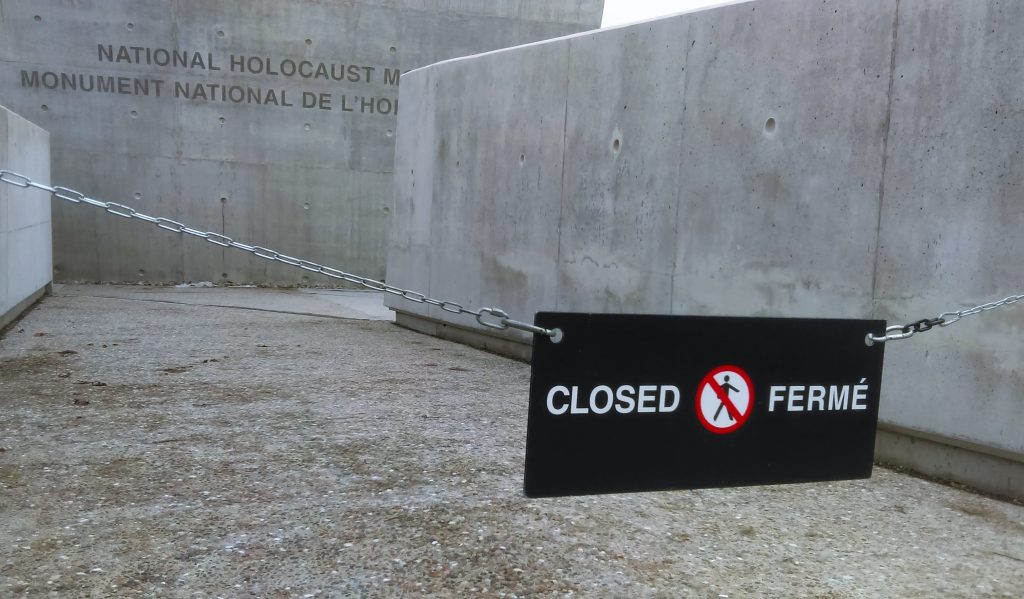National Holocaust Monument to remain open during winter
By David Sagolj
Despite snow already starting to fall, the National Holocaust Monument will stay partially open, after the initial plan to close it was met by backlash from representatives of veterans and Jewish groups.
Heritage Minister Mélanie Joly tweeted a surprise announcement on Nov. 17 that the monument, entitled Landscape of Loss, Memory and Survival, would not be closed after all.
I would like to announce that the National Holocaust Monument will be open this winter. Canadians will be able to reflect on the horrors committed against the 6 million Jewish victims & others while paying tribute to the survivors. Thank you to @CIJAinfo @LevittMichael & @NCC_CCN pic.twitter.com/6GufP5qN6X
— Mélanie Joly (@melaniejoly) November 17, 2017
“I would like to announce that the National Holocaust Monument will be open this winter,” she wrote. “Canadians will be able to reflect on the horrors committed against the 6 million Jewish victims & others while paying tribute to the survivors.”
Joly and the National Capital Commission, which manages the newly-built LeBreton Flats landmark, had previously said that the $8-million monument would close for the winter because of concerns that clearing snow would damage the structure and historical displays.
Joly’s tweet did not explain how the monument would be maintained, but the NCC — which previously said the closure was necessary to protect and preserve the monument — has revealed much of the maintenance strategy.
The monument was initially planned to have a roof and snow-melting system built into it to clear snow without plowing or shovelling, but both of those features were scrapped for budget reasons.
Cédric Pelletier, NCC’s strategic communications advisor, told Centretown News via email that “part of the main level of the Monument will be cleared this winter … to provide residents and visitors year-round access to the interpretation panels and views of the murals.”
Only about 40 per cent of the main level will be cleared, said Pelletier, and the entire second level, including the upper terrace, will be off-limits due to safety concerns.
Pelletier said that “ice melting products” would be used at the monument, alongside two machines mounted with rubber blades and brooms, which will push the cleared snow into a pile just north of the monument.
Pelletier also said that the NCC plans to monitor the maintenance operation throughout the winter.
“The National Capital Commission will evaluate the impact of the snow removal operations on the structure and integrity of the National Holocaust Monument throughout the season,” he said.
The initial plan to close the monument for the winter was met with criticism and concern. Lionel Rowe, past-president of the Royal Canadian Legion’s Montgomery branch on Kent Street, had told Centretown News that “it makes no sense,” to close such a landmark in a city known for its winter attractions.
Shimon Koffler Fogel, CEO of the Centre for Israel and Jewish Affairs, had said his organization was disappointed with the decision and was working with the NCC to solve the snow-clearing problem and keep the monument open during the winter.
Martin Sampson, CIJA’s director of communications and marketing, said the group is now pleased that Joly, along with Liberal MP Michael Levitt, engaged with CIJA to find a solution.
Sampson said that because “the monument’s purpose is Holocaust remembrance and education, it’s appropriate that Canadians have access to this site all year, particularly on International Holocaust Remembrance Day,” which takes place in January, during the peak of Ottawa’s winter.
International Holocaust Remembrance Day, which was designated by the United Nations General Assembly was created to “honour the victims of the Nazi era and to develop educational programs to help prevent future genocides,” according to the UN. It takes place on Jan. 27, the anniversary of the liberation of the Auschwitz-Birkenau concentration camp.

